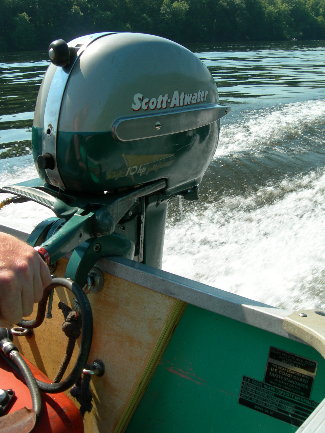Home › Forum › Ask A Member › Firestone 7.5 & 10hp outboards
- This topic has 19 replies, 12 voices, and was last updated 8 years, 11 months ago by
jeff-register.
-
AuthorPosts
-
June 3, 2015 at 9:37 pm #1671
Guys,
I enjoy the Firestone outboard & looking for a straight reply. What has been discovered with the 1948 to 1958 models as weak points in assembly to count as true bad design motors? The last Firestone 10hp I saw here in Arizona with Az tags has been over 35 years ago. Most all of my Firestone motors have been imported by me to Arizona for service to be repaired or used by me. Thanks in advance for your totally honest replys.
JeffJune 3, 2015 at 9:48 pm #17524Firestone only? Or all rebranded Scott’s? Am I looking at this right? Firestone WAS a rebranded Scott, correct?
June 3, 2015 at 11:20 pm #17533The lower shift rod threaded portion. This is where the special nut threads on that engages the fork in the lower, controlling F N R. The threaded portion is very thin and most often this is what breaks. Very weak, poor design. The gas tanks are poorly made as well. I have never seen gas tanks rot out from the inside quite like the Firestones.
June 4, 2015 at 2:07 am #17557I agree about the fuel tanks. A Mercury 3 gallon tank came with my 1954 remote tank motor, I have swapped to OMC single line tanks. May I ask exactly how your shift linkage broke & exactly where for me to avoid? At first I didn’t know how to tune & switched gears at higher rpm but now at lower rpms. I have found the shift push rod inside the prop shaft have filled with gear oil not allowing the rod to extend all the way making a hydraulic lock up not allowing for movement but the linkage is small in design to boot too but haven’t broke one yet (YES Elegable Too)
Any reed or that kind of problems too? I never have yet but not hard miles too!
JeffJune 4, 2015 at 2:51 am #17561Jeff, my 5hp Firestone had a small hole drilled in the end of the so named "shift push rod" bore to prevent hydraulic lock.
It looked factory drilled to me.Prepare to be boarded!
June 4, 2015 at 1:55 pm #17587DisCLAIMER:
Even though I have design criticisms, Firestones are one of my favorite motor brands. They run fast and well. They are rugged.
CRITICISMS:
I would echo the early gas tank issue, mine failed mechanically at the mounting studs and even solder wouldnt seal them. Second is the gear shift cam at the front of the lower unit, with some wear the shifting becomes very stiff, I have shortened the shift detent spring to remedy. Another is the "finger cutting" tilt mechanism although that may be only for Scotts. Finally the bail a matic era firestones always have pump failures, ALTHOUGH THERE IS NO BAILER THE PUMP IS MOUNTED HIGH LIKE IN THE BAILERS.June 4, 2015 at 2:49 pm #17592Jim,
Just looked up some bearings on the crankshaft. Almost everything has roller bearings except the wrist pin uses bushings except the 30 & 33 hp motors in the Scott Version. I need more data for the Firestone motor but bet they are the same. I am looking forward to restore the cast aluminum shroud motor. Can you shed any light on what year the aluminum cast shrouds were used
Thank yoy,
JeffJune 4, 2015 at 4:48 pm #17597We have several of these models, the positives are their light weight and great power – they are also somewhat unusual in classic outboard circles. Like Jim noted, just because I have issues with these doesn’t imply they aren’t a favorite!
The early (1949) 5hp and 7.5hp Scott models used a cable in place of the later stainless shift rod; these become hopelessly corroded, kinked or non-operational. I don’t know if the Firestone and Corsairs had this but, if so, look out. All of the top tank models suffer from rust inside the tank, a problem they never seemed to be able to solve since it was common right up to the last Mac 4hp in 1969! Along with the corrosion, the gas caps can become incredibly hard to unscrew and the early twist grips get stuck – this may go along with the white fungus that seems to form on all Scott plastics and is a nuisance. (In the desert you may not have this problem!)
I particularly like the unique one-year only 1953 Gold Pennant 7.5 and 10hp models and have owned several. One of the big design oversights with these is the center strip on the cover, it is a PITA to remove, something you must do to work on anything involving the recoil, magneto or carb. This same design was used, after Scott dropped it, on many of the private brand motors through 1958. A related issue is the private brand motor covers being made of steel that corrodes easily and was very poorly pained. As others have noted, the weak lower unit seals and shift shaft are a common problem. And many of you have heard my diatribe against the %&*#!! carb drain that the Scott (and others) had on the Tillotson MD – this creates a host of issues including inconsistent running and poor economy. (Some of the private brands were spared this miserable device – a good thing!) The MD also gets taxed to deliver enough fuel on the 10hp, the bowl being so shallow and the float travel only about 1/2" – they can starve for gas in tight turns or choppy conditions. Consumer Reports reviewed these motors back in 1953 and found their tilt-lock design to be unacceptable – someone must have lost a finger! I also experienced an odd issue with one of the 10s I have: it had the leg improperly machined so the driveshaft did not align correctly into the powerhead. This created a horrible sound when it was running, possibly explaining why the motor looked like new – prior owner(s) were scared to run it! The issue was glaringly obvious the second I took the powerhead off and it was not easily remedied. Some sound proofing material inside the engine cover will also make these motors a lot more enjoyable – though that is an issue with all the motors available in 1953….
As has been noted since they were new, the Bail-A-Matic Scott, Firestone, Hiawatha and Corsairs waterpump location was not well thought-out. In addition to the wear on startup and heat from the exhaust that tears up the impellers, the impeller cup with stainless liner is a problem in itself. Corrosion between the two will bow the bottom of the cup making the pump useless – this seems particularly troublesome on the private brand motors that don’t have the bailer. The only fix is to replace the unit with new, something that isn’t easy to find anymore. Scott had developed an excellent lower unit design for the 16hp and it is odd they didn’t down-scale it to the 5, 7.5 and 10hp – that front cover and the shift rod seal are terrible, I’ve never been able to get any of mine to seal 100%.
Your post was only regarding the 48-58 motors – I have yet to own one of the ’59 Scott 5, 7.5 and 10hp models. For that year only they remedied the pump issue by relocating it (and bailer) to the lower unit. I don’t believe I’ve ever seen a private brand ’59 Scott- I think Firestone had aligned with West Bend that year. Not sure about Wizard or Hiawatha, and the plug was pulled on Corsair back in ’56.
My favorite Scott – 1953 Gold Pennant 10hp (the one with the mis-aligned leg – now fixed)

Son Harry (a while back) and the 1952 Firestone 5hp

Son Graham and his 1965 McCulloch 4hp

June 4, 2015 at 5:00 pm #17598quote lotec:And many of you have heard my diatribe against the %&*#!! carb drain that the Scott (and others) had on the Tillotson MD – this creates a host of issues including inconsistent running and poor economy. (Some of the private brands were spared this miserable device – a good thing!)Is that the "Devil’s Device" I’ve heard spoken (cursed) about, that drains the carb into the water?
June 4, 2015 at 5:42 pm #17600quote Buccaneer:Jeff, my 5hp Firestone had a small hole drilled in the end of the so named “shift push rod” bore to prevent hydraulic lock.
It looked factory drilled to me.I think this detent gadget, when stuck, is what causes the unnecessary force on the shift rod and fork. Operators push harder on the shift arm. I have two, one with the hole and one without. Both are stuck in a semi compressed position. Will not shift with the detent device in place. Shifts well without it. I want to insert a probe through the hole and knock loose the cam, but this is what I do just before I break something 🙁 I can see it happening! I doubt the motor will stay in gear without the detent cam.
-
AuthorPosts
- You must be logged in to reply to this topic.

